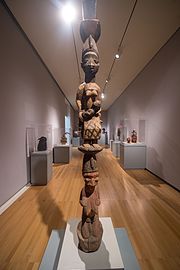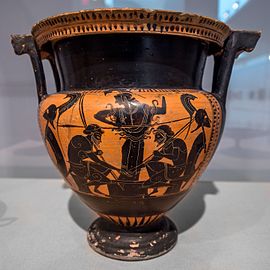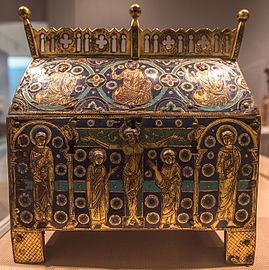Carnegie Museum of Art
This article contains promotional content. (October 2019) |
 Exterior view of the Sarah Mellon Scaife Gallery | |
 Interactive fullscreen map | |
Former name | Department of Fine Arts, Carnegie Institute |
|---|---|
| Established | November 5, 1895 |
| Location | 4400 Forbes Ave, Pittsburgh, Pennsylvania 15213 |
| Coordinates | 40°26′37″N 79°56′56″W / 40.443690°N 79.948976°W |
| Type | Art museum |
| Accreditation | American Alliance of Museums |
| Director | Eric Crosby |
| Nearest car park | On site and street |
| Website | carnegieart |
The Carnegie Museum of Art is an art museum in the Oakland neighborhood of Pittsburgh, Pennsylvania. The museum was originally known as the Department of Fine Arts, Carnegie Institute and was formerly located at what is now the Main Branch of the Carnegie Library of Pittsburgh. The museum's first gallery was opened for public use on November 5, 1895. Over the years, the gallery vastly increased in size, with a new building on Forbes Avenue built in 1907. In 1963, the name was officially changed to Museum of Art, Carnegie Institute. The size of the gallery has tripled over time, and it was officially renamed in 1986 to "Carnegie Museum of Art" to indicate it clearly as one of the four Carnegie Museums.[1]
History
Andrew Carnegie first thought of setting up a museum in 1886[2] that would preserve a "record of the progress and development of pictorial art in America." Dedicated on November 5, 1895, the art gallery was initially housed in the Carnegie Library of Pittsburgh's Main Branch in Oakland.
Carnegie initially envisioned a museum collection consisting of the "Old Masters of tomorrow".[3] The museum received a major expansion in 1907 with the addition of the Hall of Architecture, Hall of Sculpture, and Bruce Galleries, with funds again provided by Carnegie.[4]
Under the directorship of Leon A. Arkus, the Sarah Mellon Scaife Gallery (125,000 square feet) was built as an addition to the existing Carnegie Institute. Designed by architect Edward Larrabee Barnes, it first opened in 1974 and more than doubled the museum's exhibition space, also adding a children's studio, theater, café, offices, and bookstore.[5] The New York Times art critic John Russell described the gallery as an "unflawed paradise." The gallery has been renovated several times since its original creation, most recently in 2004.
Today the museum also stages the Carnegie International every few years. Numerous significant works from the Internationals have been acquired for museum's permanent collection including Winslow Homer's The Wreck (1896) and James A. McNeill Whistler's Arrangement in Black: Portrait of Señor Pablo de Sarasate (1884).
Collections and departments

The museum's curatorial departments include: Fine Arts (Contemporary Art, Works on Paper), Decorative Arts, Architecture and Photography. Every year, the museum hosts up to 15 different exhibitions. Approximately 35,000 pieces make up its permanent collection, which also includes works on paper, paintings, prints (particularly Japanese prints), sculptures, and installations from the late seventeenth century to the present. The museum has notably strong collections of both aluminum relics and chairs. Approximately 1,800 works are on view at any given time.
The museum also maintains a large archive of negatives from African American photographer Charles "Teenie" Harris.[3]
Heinz Architectural Center - The collection includes works in architecture, landscape design, engineering, and furniture and interior design. The center's facilities includes 4,000 square feet of exhibition space and a library housing several thousand books and journals.
The Hillman Photography Initiative - The Initiative hosts a variety of projects including live public events, web-based projects, documentary videos, art projects, and writing. Yearly programming is determine by a group of five "agents" who plan and curate each 12-month cycle of works hosted.[6]
Collection Themes
- Contemporary Glass
- Teenie Harris Photographs: Erroll Garner and Jazz from the Hill
- Carnegie International
- Japanese Prints
- Pittsburgh Artists
- The Art of the Chair
- Pictorialist Photography
- Painting and Sculpture 1860–1920
- W. Eugene Smith
Galleries
This section needs additional citations for verification. (May 2021) |


- Ailsa Mellon Bruce Galleries (1907) – The Ailsa Mellon Bruce Galleries were originally constructed to display reproduction bronze casts from Pompeii and Herculaneum.[7] The gallery was renovated in 2009, and currently exhibits more than 500 objects representing American and European decorative arts from the Rococo and Neoclassical periods of the 18th century to contemporary design and craft.[8]
- Hall of Architecture (1907) – The Hall of Architecture houses almost 140 full-size plaster casts of elements of buildings found in the ancient and classical civilizations of Egypt, Greece and Rome, and from Romanesque, Gothic and Renaissance Europe. It is the largest collection of plaster casts of architectural masterpieces in America and one of the three largest in the world, along with those of the Victoria and Albert Museum in London and the Musée national des Monuments Français in Paris.[9]
- Hall of Sculpture (1907) – The Hall of Sculpture was modeled after the Parthenon's inner sanctuary and was originally created to house the museum's 69 plaster casts of Egyptian, Near Eastern, Greek, and Roman sculpture. Today it exhibits works from the permanent collections, with its balcony displaying decorative arts objects from the eighteenth to the twentieth century.
- Heinz Architectural Center (1993) – dedicated to the collection, study, and exhibition of architectural drawings and models.[10]
- Scaife Galleries (1974) – The Scaife Galleries display the permanent collection of the museum,[11] and contains paintings, sculptures, works on paper, film, and video pieces.
- Forum Gallery – Located on the first floor of the museum just inside the Forbes Avenue entrance, this single room is dedicated to temporary exhibitions of contemporary art. It opened November 3, 1990, with support from the National Endowment of the Arts – The first exhibition, Forum 1, was a solo show of Jeff Wall. Subsequent exhibitions were numbered sequentially (for example, Forum 40 featured Felix de la Concha). Unlike larger museum exhibitions, which can take up to three years to plan and execute, Forum shows come together relatively quickly, and are open to any curatorial staff's vision. In the words of Vicky Clark, a longtime curator at the museum, "The idea was to make sure that we had an exhibition of contemporary art set up at all times."[12]
Educational programs
Saturday art classes in the galleries of the Carnegie Museum of Art have been conducted for over 75 years. Alumni of the program include Andy Warhol, photographer Duane Michals, and contemporary artist Philip Pearlstein. [citation needed] The museum has classes specific to various age groups.[13]
Looted art controversy
In 2023 the Manhattan District Attorney seized a drawing by Egon Schiele entitled Portrait of a Man within the framework of a criminal investigation concerning the Nazi-era looting of the collection of Fritz Grunbäum, who was murdered in the Holocaust.[14][15]
Gallery
-
Bronze ritualistic vessel, 1300–1150 BCE, Shang dynasty, China
-
Housepost, c. 1930s, Yoruba culture, Africa
-
Ancient Greco-Roman vase
-
Casket for relics of a saint (châsse), 13th century, French
-
Ivory portable altar, 14th century, French
-
Armour, with Helmet, c. 1555, by Anton Peffenhauser
-
View of the Great Fire of Pittsburgh, 1846, oil on canvas, by William Coventry Wall
-
Farallon Island, 1887, oil on canvas, by Albert Bierstadt
-
Wheat Fields After the Rain (The Plain of Auvers), 1890, oil on canvas, by Vincent van Gogh
-
Place des Lices, 1893, oil on canvas, by Paul Signac
-
Steamboat on the Ohio, 1896, oil on canvas, by Thomas Pollock Anshutz
-
Water Lilies (Nymphéas), 1915–1926, oil on canvas, by Claude Monet
-
Miniature room box on display, Ruth McChesney
Past directors
- John W. Beaty (1896–1921)[16]
- Homer Saint-Gaudens (1922–1950)
- Gordon Bailey Washburn (1950–1962)[17]
- Gustave Von Groschwitz (1963–1968)
- Leon Arkus (1968–1980)[18]
- John R. Lane (1980–1987)[19]
- Phillip M. Johnston (1988–1996)[20]
- Richard Armstrong (1996–2008)[21]
- Lynn Zelevansky (2009–2017)
- Eric Crosby (2018–present)[22]
See also
- Carnegie Museums of Pittsburgh
- Homer Saint-Gaudens
- Frick Art & Historical Center
- List of museums in Pennsylvania
- List of largest art museums
- Sally Dixon
References
- ^ "History". Carnegie Museum of Art. Retrieved 2022-12-21.
- ^ W. J. Holland, LL.D., "The Carnegie Museum", in Popular Science, May 1901.
- ^ a b About Carnegie Museum of Art: History Archived October 13, 2008, at the Wayback Machine
- ^ Memorial of the celebration of the Carnegie Institute at Pittsburgh, Pa., April 11, 12, 13, 1907.
- ^ Ellen S. Wilson, "The Continuing History of the Scaife Galleries", in Carnegie Online, July/August 2003 "Carnegie Online". Archived from the original on 2008-09-07. Retrieved 2009-11-29..
- ^ Hillman Photography Initiative Announced
- ^ Gangewere, Robert J. (2011). Palace of culture : Andrew Carnegie's museums and library in Pittsburgh. Pittsburgh, Pa. ISBN 978-0-8229-7969-2. OCLC 871325567.
{{cite book}}: CS1 maint: location missing publisher (link) - ^ "Carnegie Museum of Art Announces the Redesign of the Ailsa Mellon Bruce Galleries". artdaily.
- ^ "Hall of Architecture". Carnegie Museum of Art.
- ^ "Hall of Sculpture". Carnegie Museum of Art.
- ^ Crosby, Eric (2018). "Museum Collections and the Stories They Tell". Carnegie Museums of Pittsburgh.
- ^ Pifer, Jenelle (Winter 2015). "The Art of the Now". Carnegie. Carnegie Museum of Art: 24–29.
- ^ "School of Rock, Art, and Science". Carnegie Museums of Pittsburgh.
- ^ "Egon Schiele art seized in US over Holocaust claim". BBC News. 2023-09-14. Retrieved 2023-11-08.
- ^ Mashberg, Tom (2023-09-14). "Schiele Works Believed to Be Stolen Are Seized From U.S. Museums". The New York Times. ISSN 0362-4331. Retrieved 2023-11-08.
- ^ "Historical Note | A Finding Aid to the Carnegie Institute, Museum of Art records, 1883-1962, bulk 1885-1962 | Digitized Collection". www.aaa.si.edu. Retrieved 2022-02-03.
- ^ "Oral history interview with Gordon Bailey Washburn, 1970 March 4-18". www.aaa.si.edu. Retrieved 2022-02-03.
- ^ "The Time of Arkus". Pittsburgh Quarterly. Retrieved 2022-02-03.
- ^ "John R. Lane, Class of 1966". Alumni Awards. Retrieved 2022-02-03.
- ^ Gangewere, Robert J. (2011-09-30). Palace of Culture: Andrew Carnegie's Museums and Library in Pittsburgh. University of Pittsburgh Press. ISBN 978-0-8229-7969-2.
- ^ "Richard Armstrong becomes Director of Carnegie Museum of Art". carnegiemuseums.org. Retrieved 2022-02-03.
- ^ "Eric Crosby to Lead the Carnegie Museum of Art". www.artforum.com. 28 February 2020. Retrieved 2022-02-03.
External links
- Carnegie Museum of Art
- 1896 establishments in Pennsylvania
- Andrew Carnegie
- Art museums and galleries established in 1896
- Art museums and galleries in Pennsylvania
- Asian art museums in the United States
- Edward Larrabee Barnes buildings
- Institutions accredited by the American Alliance of Museums
- Modern art museums in the United States
- Museums in Pittsburgh
- Plaster cast collections
- Tourist attractions in Pittsburgh














